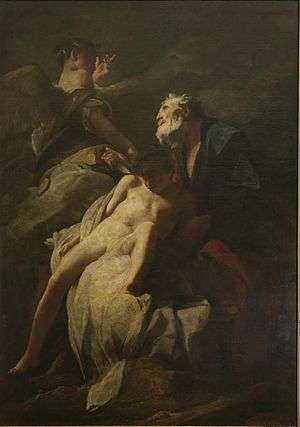Federiko Benković

Federiko Benković (1667 – 8 July 1753) was a prominent late Baroque painter working in Italy. He is best known as Federico Bencovich or Federico Bencovic, but also as Federigo or Federighetto or Dalmatino.
He was born from a Croatian family. His birthplace is unknown, either in Omiš, Šibenik, the island Brač, Ragusa (Dubrovnik), or possibly Venice itself.

His initial training was likely in Venice, but later Benković apprenticed with Carlo Cignani in Bologna, assisting him in 1706 in completing the frescoes of the Assumption of the Virgin on the dome of the Forlì cathedral. His first independent work, Juno on the clouds, was painted in 1705. He also appears to have worked in the studio of Giuseppe Maria Crespi.
In 1710 Benković painted the altarpiece of St. Andrew on the cross surrounded by St. Bartholomew, St. Carolus Borromei, St. Lucia, and St. Apollonia for the church of Madonna del Piombo in Bologna, later transferred to the parish church of Senonches near Chartres in France. By 1715, he came to the service of the Archbishop-Elector of Mainz Lothar Franz von Schönborn and was to complete four large canvas masterpieces for the gallery in the Schloss Weißenstein in the town of Pommersfelden: Apollo and Marcia, Hagar and Ishmael in the Desert, Iphigenia’s sacrifice and Abraham’s sacrifice of Isaac.
 Hagar and Ishmael in the Desert
Hagar and Ishmael in the Desert Iphigenia’s sacrifice
Iphigenia’s sacrifice
The dramatic, often tortured, poses and lighting of his figures are placed within earthy tenebrist backgrounds, He uses Piazzetta's and Sebastiano Ricci's unfinished and ragged brushstrokes, but superimposes a startling mystical imprint that is often foreign to the magisterial and olympian Venetian painting, and more akin to the Baroque painters from Northern Italy, Alessandro Magnasco and Francesco Cairo.
Abraham's Sacrifice of Isaac[1] is probably the painting that disappeared from the castle of Pommersfelden at the beginning of the 19th century. Until that time, the painting was attributed to Piazzetta.
Before his death, he moved to his hometown of Kamnik, Slovenia, where he, after his death, gradually fell into oblivion. His paintings used to be attributed to Piazzetta or Cignani, amongst others.
References
- ↑ Now in the Strossmayer gallery in Croatia, after they bought the painting at a London auction in 1936.
External links
| Wikimedia Commons has media related to Federiko Benković. |